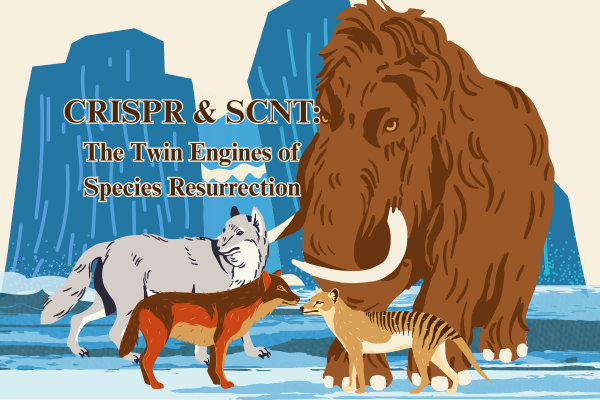De-extinction: although the word may evoke images of Jurassic Park-esque scenarios, modern-day science is far from these dramatized scenarios. De-extinction is a proposed method of resurrecting extinct species through synthesizing DNA with genome editing, synthetic genomics, or cloning.
Cloning can be seen as a more attainable method of de-extinction, however, it may only be used when there is a source of DNA from the extinct animal as well as a close living relative.
Leaps and bounds have been made in this realm of science, one of the largest being Colossal Laboratories and Sciences. Colossal was founded in 2021 by George Church and Ben Lamm, both with experience in genetics. The organization was founded with the overarching goal of bringing back the wooly mammoth. It has since expanded to encompass the thylacine and the dodo bird. The type of de-extinction you may imagine has never actually happened, however, in the context of cloning, it has.
Dolly the sheep is a well-known example of cloning, but many don’t realize the impact it has had on de-extinction. Taken from Scientific American, a falling tree killed the last bucardo named Celia in 2000, a species of ibex, a wild goat. Later, in 2003, a clone was created. Scientists could extract DNA from Celia and insert it into the egg cell of another ibex, transferring the embryo to a goat. Around a year later, they were able to deliver the clone. Although the clone only lived for about seven minutes due to lung defects, scientists were able to temporarily bring the bucardo back from extinction.
Another major advancement in de-extinction, CRISPR, or clustered regularly interspaced short palindromic repeats, is the most pertinent development in the field. CRISPR involves editing DNA and comparing the genome of an extinct animal and one of its living relatives, inserting critical parts of the extinct animal’s genome into its relatives. A great example of this would be inserting the gene for cold resistance into an Asian elephant’s genome. Despite sounding simple, CRISPR is more complicated than that, as most of the time the entire genome is unable to be recovered from the extinct species.
In addition to this, CRISPR isn’t able to exactly create the extinct species.
The Christmas Island rat study in 2022 determined that genome editing can only create a “hybrid” of two species. In the study, about five percent of the rat’s genome was unrecoverable, and the resulting animal lacked the original species’ olfactory senses and immune systems. Even though a replica of an extinct species may be unrealistic with this method, creating these “hybrid” animals is a step in the right direction.
CRISPR technology may be used to create a “hybrid” or “proxy”, which could then be used as the subject of selective breeding, or back-breeding, which is a method of breeding animals with select traits relating to ancestors. Back-breeding has been attempted before, around the 1920s, most notably in the de-extinction attempt of the aurochs, an ancient type of cattle that went extinct in 1627. These were the product of Heck cattle, and again around the early 90s, using pre-existing Heck cattle called the Taurus Project. A similar project was done with extinct Tarpan horses. Although these projects did not use CRISPR technology, they have led to further efforts to resurrect keystone species. Although back-breeding may yield positive results, it can never create a replica of the extinct animal, only a “proxy.”
With the current rate of extinction, de-extinction will likely become an up-and-coming field of science that we may rely upon. Whether it’s by creating “proxies” or cloning exact replicas, modern-day CRISPR technology with the addition of back breeding could be just what we need to bring extinct species back from the dead.














